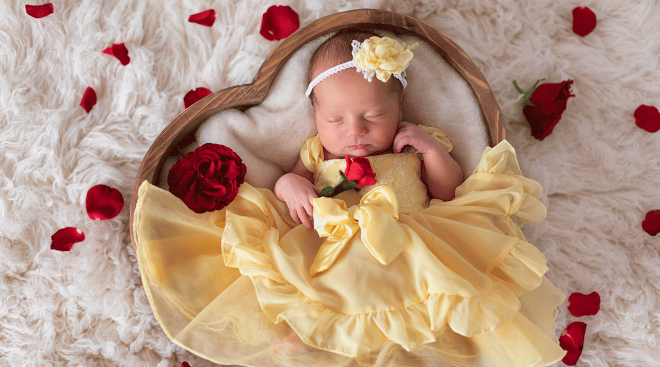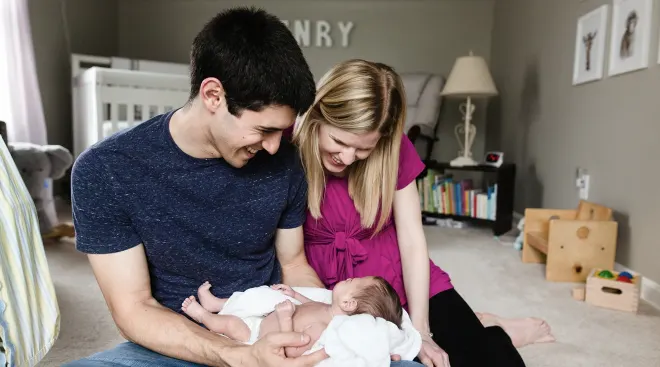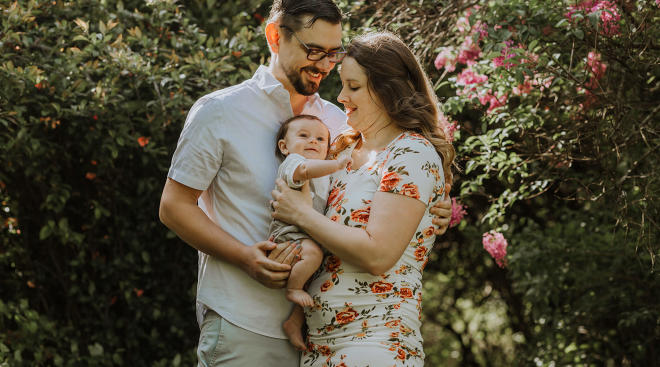When Do Babies Recognize Their Name?
Before baby’s arrival, you spent countless hours scouring baby name lists, mulling over the options and potentially polling family and friends. You might have googled your top name pick and practiced writing it, saying it, maybe even yelling it. And now that baby’s here, their name is constantly on your lips, so it’s natural to wonder: When do babies recognize their name? Here, experts break down when babies learn their name and start to respond to it.
You’re eager to call baby by their name and see them respond, but before baby can reach this milestone, they have to develop a few other skills, says Jana Sarno, a board-certified behavior analyst and the chief clinical officer at Hopebridge Autism Therapy Centers. “They should be able to localize sound and respond to loud sounds around 2 to 4 months, which includes being startled by noises such as a car honking or dog barking.” So exactly when do babies respond to their name? Sarno says it can be anywhere between 4 and 9 months, as this is the time frame baby starts to learn more communication and social skills.
“At the 9-month well visit we expect babies to turn their heads briefly when their name is called,” says Julie Capiola, MD, a pediatrician at Premier Pediatrics in New York City. But Capiola emphasizes that "all development is on a continuum;” some babies may respond to their name a little earlier or a little later. “What’s important is that their overall social development is progressing, and that they’re doing things like responding to what you say and do, and making their own noises to try and get your attention,” Capiola adds.
It’s also important to note this age range is specific to baby’s first name, since it’s less common for family members to use their last name on a regular basis in a family setting. Infants should be able to consistently respond to their name between 9 to 12 months, but recognizing their last name may not occur until they’re between 2 and 4 years old, says Sarno.
Signs baby recognizes their name
You’ll know baby’s starting to recognize their name when they respond to it being called. Sarno, calls out some signs of recognition, including:
- Smiling
- Making eye contact and looking at you
- Pausing their activity and turning their head
Older infants may also babble back to you when their name is called, Sarno says, adding that caregivers should try calling baby’s name to see if they get a babble response back.
When do babies say their name?
Some toddlers take a stab at saying their name around 18 months, but it could also be a few more months before this happens—and that’s okay. As exciting as it is to hear baby babble some version of their name, it isn’t actually a baby milestone that doctors look for. After 18 months, baby will go through a language explosion, and by 24 months, toddlers will be able to speak up to 100 words, including their name. At the latest, children should be able to say their first name by the time they’re 3 years old, and write it by age 5.
According to Sarno, babies are starting to learn their names long before they can speak—it happens throughout everyday moments you may deem insignificant. “Their communication process begins with receptive language… Infants will likely learn to recognize their caregivers’ voices before specific words,” she explains.
The primary way babies learn their names is through repetition—and you’re likely saying baby’s name often, even unknowingly, during baby talk. “Babies probably hear their name more than any other word. As parents, we incorporate baby’s name into daily routines, while also adding in tons of nicknames,” says Jocelyn M. Wood, a bilingual speech language pathologist based in New York City says. “Babies recognize these routines, and as they near the 6 to 7 month age range, they begin to parse out these words and understand that they refer to themselves.”
Plus, once little ones begin daycare or preschool, they may have activities like circle time, during which kids sing songs with everyone’s names to build repetition and instill recognition.
So what can parents and caregivers do to help baby recognize their name? It’s all about repetition, all three experts say: Calling your child by their name over and over again provides the reinforcement babies need to learn. “When we set up routines for our family, we can ensure that we’re using the same vocabulary every day, which helps children better understand their environment and the words that guide it,” Wood explains.
To help encourage speech, it’s important to talk to your child daily, even if they’re not yet responding. You can reinforce your toddler’s name by weaving it into everyday moments. Sarno recommends saying things like, ““Good morning, Kai,” “Olivia, look at this” and “Do you like your blueberries, Jayden?” But, as you talk to baby, limit outside noise and distractions (like from the television or music) to help them focus on learning this new skill, Wood adds. Plus, change your intonation when you talk to baby and draw out their name to help it stand out to them.
You can even have one-sided conversations you narrate as you do activities with baby. “Be sure you’re mixing in lots of adjectives and verbs because all of this helps enhance language skills,” encourages Capiola.
Another fun way to help teach baby their name is with games and activities, like Peek-a-boo, Sarno says. “Include phrases like, ‘Where is Liam? There he is!’” Parents can also sing songs to baby that include their name or read a personalized book that includes their name to build recognition. Wood also recommends looking in the mirror when you talk to baby and saying their name. “Not only can looking in a mirror help your child make a connection to themselves, they can also watch you and your mouth movements and begin to associate these patterns with their own name,” she says.
If baby is between 9 and 12 months and not consistently responding to their name when called, parents should bring it up to their pediatrician. “Depending on other milestones and behaviors, they could be experiencing hearing challenges,” Sarno says. “Make an appointment to have your child’s hearing tested—even if you think they hear you, it may be that they have fluid in their ears,” adds Wood.
If baby is startled and turns toward other sounds, but isn’t responsive to their name, it may be an early sign of autism or other developmental disorder, Sarno says. If you’re concerned about baby’s development or have any questions, get in touch with your pediatrician.
Seeing baby respond to their name and gain self-awareness is exciting. But your little one may reach this milestone in their own time. In the meantime, keep repeating that name you carefully, lovingly chose.
Please note: The Bump and the materials and information it contains are not intended to, and do not constitute, medical or other health advice or diagnosis and should not be used as such. You should always consult with a qualified physician or health professional about your specific circumstances.
Plus, more from The Bump:
Julie Capiola, MD, is a pediatrician at Premier Pediatrics in New York City, as well as a clinical instructor of pediatrics at NYU’s Grossman School of Medicine. She earned her medical degree from Thomas Jefferson University and completed her residency in pediatrics at Yale New Haven Hospital.
Jana Sarno, is a board-certified behavior analyst and the chief clinical officer at Hopebridge Autism Therapy Centers. She earned her degree in psychology from Western Michigan University and The University of Southern Mississippi.
Jocelyn M. Wood, MA, CCC-SLP, is a New York City-based bilingual speech language pathologist with over a decade of experience. She specializes in working with parents who are seeking advice on how to introduce speech and language activities into everyday routines. She earned her master’s degree in speech and language pathology from Hofstra University.
Learn how we ensure the accuracy of our content through our editorial and medical review process.
Navigate forward to interact with the calendar and select a date. Press the question mark key to get the keyboard shortcuts for changing dates.





















































